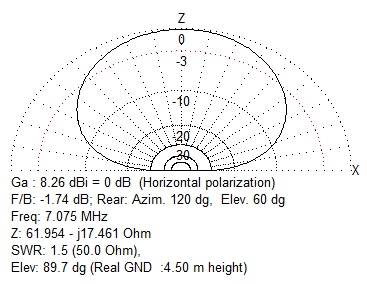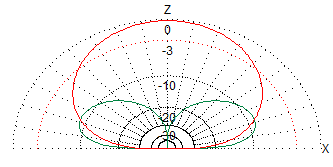 I check into the HamAntennas Yahoo Group fairly often and it occurs to me that collectively, there seems to be a lot of smoke and mirrors surrounding the design of low-band antennas and everyone seems to forget the basic principles, that low-to-the-ground antennas will form bubbles of RF above you. We call them NVIS or Cloud Burner antennas. The graphic is a plot of my home-brew 40m loop in the garden from MMANA. It’s 25 feet above the ground (which is exactly the same far-field plot as an 80m loop at 50 feet). Clearly it’s going to work well at what it’s designed for. Up to about 1,500 miles. In practice, it conforms precisely to my software plot.
I check into the HamAntennas Yahoo Group fairly often and it occurs to me that collectively, there seems to be a lot of smoke and mirrors surrounding the design of low-band antennas and everyone seems to forget the basic principles, that low-to-the-ground antennas will form bubbles of RF above you. We call them NVIS or Cloud Burner antennas. The graphic is a plot of my home-brew 40m loop in the garden from MMANA. It’s 25 feet above the ground (which is exactly the same far-field plot as an 80m loop at 50 feet). Clearly it’s going to work well at what it’s designed for. Up to about 1,500 miles. In practice, it conforms precisely to my software plot.
Most people though seem to think that their home-brew contraption is particularly good because they checked into a 75/80m net 1,000 miles away. Yes, you can do that with NVIS, so don’t worry! Your radio works. Big deal. All that you are doing is forming a healthy bubble of RF above your antenna. That’s the easy bit and why all the folks are out there on 75/80m bands. Heck, I like NVIS. It’s fun and it means that you can talk to you friend up the road. Great!
I read a lot of literature on antenna theory (and practice) and as many of you know, I have built hundreds (I exaggerate, but not my much!) of antennas and most have been put to the 500 QSO test. Frankly, there is so much bull about them that I can hardly contain myself sometimes. There are a number of camps, like those that like to design antennas and circuits that relate to a near 50 ohm impedance. I can buy that. It’s difficult to get an antenna to just the right SWR curve based on 50 ohm coax and I appreciate the time and attention to detail that the coax freaks enjoy. I am one of them. This is probably the biggest topic out there and it’s good for amateur radio.
Then there are those that don’t care about 50 ohms, although they still feed with coax and dial it out with a tuner. They heat up coax and probably cause TVI. Not a good practice and we need to help these guys.
Then we have the guys that throw the book away and feed everything and anything with 450 ohm, or open wire feeder and sort it all out with their favorite tuner, well good luck to them. They brag about loading up trucks, guttering, fence posts and gates. Yeah, you can do that. Get over it. Of course, that’s not to say that people who use 450 ohm feedlines throw the books away, but for my convenience, I’ll forget you quiet guys. You say little because you know how it all works and I respect you for that 🙂
The only way you can get either a bigger or flatter bubble above you (or a lower angle of radiation which is the same thing really) is to become either extremely efficient, high or very clever and there’s only a few clever AND low designs that I know about. Most of these revolve around vertically polarising the signal to keep the heights manageable by using quarter wave vertical principles. They tend to use similar concepts to Yagi; they squirt the appropriate RF in mostly one direction. The Half Square, the Bobtail Curtain are very good at this, as are 4-squares and other phased arrays.
 The rule is that if it’s horizontally polarised and under about a third of a wavelength in height, it will successfully shove a bubble of RF over your head, the higher – the flatter it will be. You will be happy regardless of length or how you feed it, I’m sure. If it’s vertical it will probably be pretty inefficient but it will no doubt secure some DX for you, however it will only work best from about 250 miles plus. You will miss your friends locally. See the plot, green is a quarterwave vertical compared to a red plot, – my 40m loop – it’s pretty easy to grasp, I’m talking to licensed amateurs here.
The rule is that if it’s horizontally polarised and under about a third of a wavelength in height, it will successfully shove a bubble of RF over your head, the higher – the flatter it will be. You will be happy regardless of length or how you feed it, I’m sure. If it’s vertical it will probably be pretty inefficient but it will no doubt secure some DX for you, however it will only work best from about 250 miles plus. You will miss your friends locally. See the plot, green is a quarterwave vertical compared to a red plot, – my 40m loop – it’s pretty easy to grasp, I’m talking to licensed amateurs here.
All camps will be happy though, because they’ll work anything they can hear. Be aware, that working only those stations you can hear (and working up to 1,500 miles on 80m) can be done with a set of step-ladders so it’s not a good argument about how good your antenna is – be careful about what you are bragging about.
To conclude, by all means, let’s all tinker away with every conceivable gadget and idea, just remember that regardless of how we feed these things, or what they look like – if it’s low down to the ground, the best you’ll do is get a bubble of RF into the sky, but that’s fine. They work. The good news is that regardless how you do this, most of the bubbles will be the same size, full stop. It’s not about whether your antenna goes around a tree up a gutter, round the house or inside the attic or drivel like this. For the low bands, it’s completely irrelevant, just get some wire out there and find something that will match it to your radio. Did you hear about the guy that worked 100 countries one year on 160m with an antenna that was only 10m (30′) above the ground? That’s the same as having a 40m antenna, only 2.5 meters (7’6″) in the air! Look at all those people who got fed up with antennas – they went and bought an SG230 and strung up a couple of pieces of wire over the roof to an apple tree. It worked great and all their problems went away. The matching was taken off their hands, all they had to do was come up with an idea where to shove their wire. Let’s face it, that’s certainly not the difficult bit, eh?
73